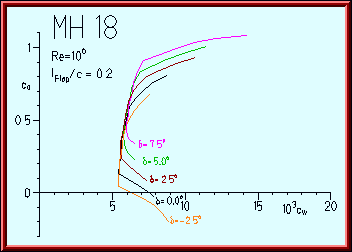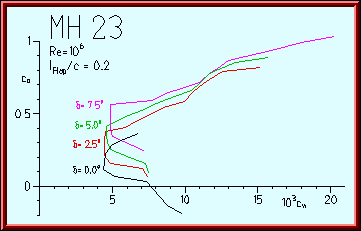|
Flaps in Pylon Racing Models ? |
Using flaps in pylon racing models may help to adapt the airfoil of the wing to the flight envelope. By deflecting the flap, the camber of the airfoil is changed, which makes it possible to move the drag polar Cl=f(Cd) up and down. When the low drag region of the polar (laminar bucket) can be adjusted to the flight condition, a thinner airfoil can be used, which may result in lower drag.
Two airfoils have been analyzed for different flap deflections, using the computer code XFOIL. The first airfoil, MH 18 is relatively thick (11.14%), whereas the second one, the MH 23 is much thinner (8.01%) and also features a more pronounced laminar bucket.
The drag polars of both airfoils were calculated for a 20% deep flap at a Reynolds number of 1'000'000. Looking at the results, it should be noted, that the lift coefficient Cl, necessary for pylon racing, mainly falls in the range between approximately 0.0 and 0.6; higher lift coefficients are usually not needed.

Drag polars for the 11.1% thick MH 18, equipped with a 20% chord length
flap.
The polar of the MH 18 moves smoothly up and down when the flap angle is changed. Using the default configuration (delta=0º), the laminar bucket extends from Cl=0.1 to Cl=0.6, which is sufficient, but could be improved by applying -2.5º flap deflection. It remains questionable, whether the improvement justifies the additional work of installation and the problems of control.

Drag polars for the 8% thick MH 23, equipped with a 20% chord length flap.
The thinner MH 23 is a much more extreme design, which results in less drag, but also in a very narrow laminar bucket. Without a flap, which is adjusted according to the necessary lift coefficient, the low drag region ranges from Cl=0.1 to 0.3. For a successful usage of this airfoil, a flap, whose deflection may be linked to the elevator deflection is recommended. For tight turns, the maximum deflection may reach 7.5º; during the straight and level parts of the flight a negative flap setting of -2.0º should be used.
Thick airfoil sections, like the MH 18, usually cover a range of lift coefficients, which is wide enough without using flaps. On the other hand, modern radio control equipment reduces the effort to the installation of a second aileron servo.
When using thinner, low drag airfoil sections (like the MH 23...MH 27 series), a flap is well worth the effort, or even absolutely necessary, to get all the benefits out of these airfoils.
Because there is no time to manually adjust the flap setting, it has to be linked to the elevator, which is rather difficult to adjust.
Last modification of this page: 21.05.18
![]()
[Back to Home Page] Suggestions? Corrections? Remarks? e-mail: Martin Hepperle.
Due to the increasing amount of SPAM mail, I have to change this e-Mail address regularly. You will always find the latest version in the footer of all my pages.
It might take some time until you receive an answer
and in some cases you may even receive no answer at all. I apologize for this, but
my spare time is limited. If you have not lost patience, you might want to send
me a copy of your e-mail after a month or so.
This is a privately owned, non-profit page of purely educational purpose.
Any statements may be incorrect and unsuitable for practical usage. I cannot take
any responsibility for actions you perform based on data, assumptions, calculations
etc. taken from this web page.
© 1996-2018 Martin Hepperle
You may use the data given in this document for your personal use. If you use this
document for a publication, you have to cite the source. A publication of a recompilation
of the given material is not allowed, if the resulting product is sold for more
than the production costs.
This document may accidentally refer to trade names and trademarks, which are owned by national or international companies, but which are unknown by me. Their rights are fully recognized and these companies are kindly asked to inform me if they do not wish their names to be used at all or to be used in a different way.
This document is part of a frame set and can be found by navigating from the entry point at the Web site http://www.MH-AeroTools.de/.